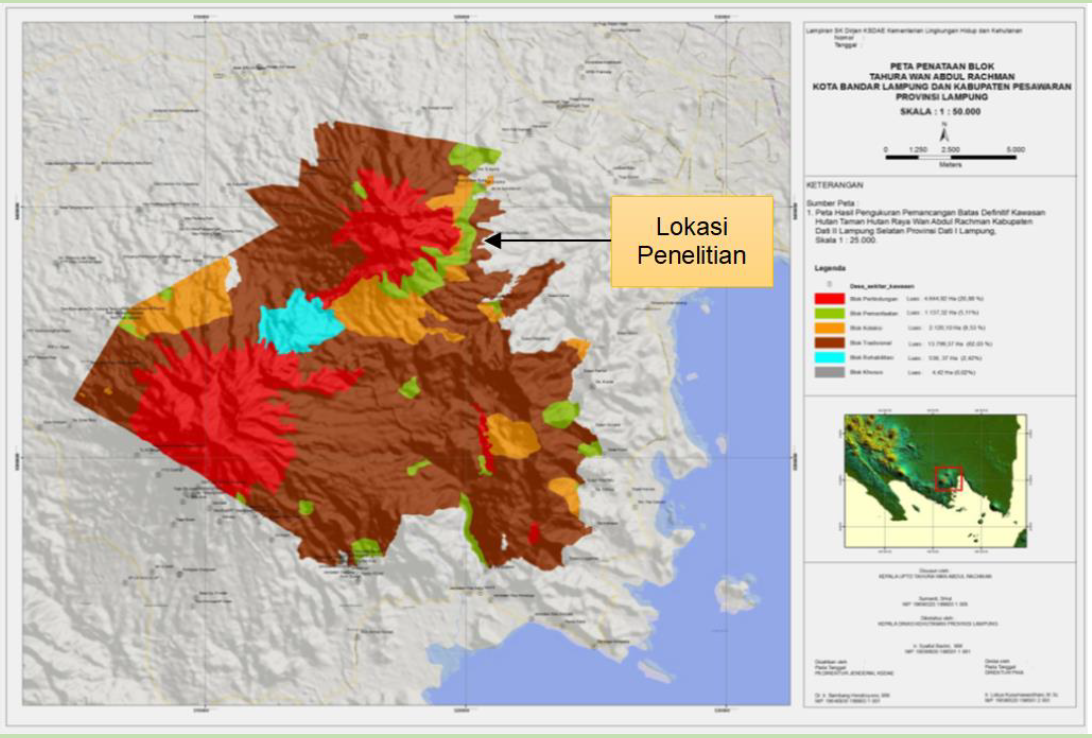Composition, domination, and similarity level of stand among farmers' cultivated blocks at Wan Abdul Rachman Grand Forest Park

Downloads
Arifiani, D. & Mahyuni, R. (2012). Keanekaragaman flora di Taman Nasional Bukit Barisan Selatan, Provinsi Lampung. Berita Biologi, 11(2), 149–160.
Bohn, F. J., May, F., & Huth, A. (2017). Species composition and forest structure explain the temperature sensitivity patterns of productivity in temperate forests. Biogeosciences, 15(6), 1-26.
Busyra, B. S. &. Firdaus. (2010). Rekomendasi pemupukan tanaman padi dan palawija pada lahan kering di Provinsi Jambi. First ed. Jambi: Balai Pengkajian Teknologi Pertanian Jambi.
Christopher, A. O. (2020). Comparative analyses of diversity and similarity indices of West Bank Forest and Block A Forest of the International Institute of Tropical Agriculture (IITA) Ibadan, Oyo State, Nigeria. International Journal of Forestry Research, 2020, 1–8.
Departemen Kehutanan Republik Indonesia. (2008). Peraturan Menteri Kehutanan Nomor P.70/Menhut-II/2008 Tentang Pedoman Teknis Rehabilitasi Hutan dan Lahan.
Dey, A. & Akther, A. (2020). Tree species composition and natural regeneration status in South Eastern Bangladesh. Journal of Tropical Biodiversity and Biotechnology, 05(01), 27–34.
Dwiprabowo, H., Effendi, R., Hakim, I., & Bangsawan, I. (2011). Kontribusi kawasan hutan dalam menunjang ketahanan pangan: studi kasus Provinsi Jawa Barat. Jurnal Analisis Kebijakan Kehutanan, 8(1), 47–61.
Fatehi, P., Damm, A., Leiterer, R., Bavaghar, M. P., Schaepman, M. E., & Kneubuhler, M. (2017). Tree density and forest productivity in a heterogeneous alpine environment: insights from airborne laser scanning and imaging spectroscopy. Forests, 8 (212), 1–21.
Gapoktanhut Harapan Baru. (2019). Profil Kelompok Tani Hutan Harapan Baru. Bandar Lampung: Desa Batu Putuk Kecamatan Teluk Betung Barat.
Giesen, W. (1991). Berbak Wildlife Reserve, Jambi. Bogor.
Gopal, B. & Bhardwaj, N. (1979). Elements of Ecology. First ed. Sahibabad: Vikas Publishing House PVT LTD.
Gunawan, W., Basuni, S., Indrawan, A., Prasetyo, L. B., & Soedjito, H. (2011). Analisis komposisi dan struktur vegetasi terhadap upaya restorasi kawasan hutan Taman Nasional Gunung Gede Pangrango. Jurnal Pengelolaan Sumber Daya Alam dan Lingkungan, 1(2), 93–105.
Hartoyo, A. P. P., Karimatunnisa, T. A., Ikhfan, A.N., Wijayanto, N., & Azizah, S. (2019). Vegetation structure, composition and diversity in agroforestry system in Andongrejo Village, Jember Regency, East Java. ICAF SEANAFE 2019, IOP Conf. Series: Earth and Environmental Science, 449(2020) 012017, 1–14.
Indriyanto, Bintoro, A., & Yuwono, S. B. (2001). Identifikasi sistem budidaya dan komposisi jenis tumbuhan di areal Hutan Kemasyarakatan Register 19 Gunung Betung, Lampung. Pp. 95–102 in Proseding Seminar Nasional Pengelolaan Sumber Daya Alam untuk Mencapai Produktivitas Optimum. Vol. II. Berkelanjutan. Bandar Lampung: Universitas Lampung.
Indriyanto, Surnayanti, & Tsani, M. K. (2018). Tingkat kesamaan komposisi tegakan hutan antargarapan petani KPPH Talangmulya. Laporan Penelitian No. 132. LPPM Universitas Lampung. Bandar Lampung.
Indriyanto. (2010). Pengantar Budidaya Hutan. kedua. Jakarta: PT Bumi Aksara.
Indriyanto. (2019). Ekologi Hutan. Jakarta: PT Bumi Aksara.
Indriyanto. (2021). Metode Analisis Vegetasi dan Komunitas Hewan. 2nd ed. Yogyakarta: Graha Ilmu.
Indriyanto & Asmarahman, C. (2019). Jenis tanaman penyusun tegakan sebagai sumber pangan di areal garapan petani gabungan KPPH Sumber Agung dalam Taman Hutan Raya Wan Abdul Rachman. Pp. 372–382 in Prosiding Seminar Nasional Perhimpunan Biologi Indonesia XXV. Bandar Lampung: Perhimpunan Biologi Indonesia Cabang Lampung.
Kitalyi, A., Otsyina, R., Wambungu, C., & Kimaro, D. (2013). FAO characterisation of global heritage agroforestry systems in Tanzania and Kenya. Dodoma.
Kusmana, C., Saharjo, B. H., Sumawinata, B., Onrizal, & Kato, T. (2009). Komposisi jenis dan struktur hutan hujan tropika dataran rendah di Taman Nasional Danau Sentarum, Kalimantan Barat. Jurnal Ilmu Pertanian Indonesia, 14(3), 149–157.
Liu, N., Wang, Y., Wang, Y., Zhao, Z., & Zhao, Y. (2016). Tree species composition rather than biodiversity impacts forest soil organic carbon of three gorges, Southwestern China. Nature Conservation, 14, 7–24.
Murniati, Suharti, S., Yeny, I., &. Minarningsih. (2022a). Cacao-based agroforestry in conservation forest area: farmer participation, main commodities and its contribution to the local production and economy. Forest and Society, 6(1), 243–274.
Murniati, Suharti, S., Minarningsih, Nuroniah, H. S., Rahayu, S., & Dewi, S. (2022b). What makes agroforestry a potential restoration measure in a degraded conservation forest?. Forests, 13(267), 1–17.
Nair, P. K. R. (1993). An Introduction to Agroforestry. Netherlands: Kluwer Academic Publishers.
Odum, E. P. (1971). Fundamentals of Ecology. 3rd ed. Philadelphia: W. B. Saunders Company.
Pemerintah Republik Indonesia. (1990). Undang-undang Nomor 5 Tahun 1990 Tentang Konservasi Sumber Daya Alam Hayati dan Ekosistemnya.
Pemerintah Republik Indonesia. (2015). Peraturan Pemerintah Nomor 108 Tahun 2015 Tentang Perubahan Atas Peraturan Pemerintah Nomor 28 Tahun 2011 Tentang Pengelolaan Kawasan Suaka Alam dan Kawasan Pelestarian Alam.
Pramono, D. A. (2016). Sebaran jenis tanah di sub daerah aliran sungai Karang Mumus menggunakan sistem informasi geografis. Jurnal Teknologi Informasi Universitas Lambung Mangkurat, 1(2), 31–43.
Shanin, V., Komarov, A., & Makipaa, R. (2014). Tree species composition affects productivity and carbon dynamics of different site types in boreal forests. European Journal of Forest Research, 133, 273–286.
Sirajudin, N., Ridwan, M., & Malamassam, D. (2021). Agroforestry development strategy in West Halmahera Regency, North Maluku. International Journal of Science and Management Studies, 4(4), 117–125.
Soekotjo. (2009). Teknik Silvikultur Intensif. Yogyakarta: Gadjah Mada University Press.
Susanty, F. H. (2020). Pola kerapatan dan keragaman tegakan hutan dipterocarpa sekunder. Jurnal Penelitian Hutan Tanaman, 17(1), 41–51.
Tynsong, H., Tiwari, B. K., & Dkhar, M. (2017). Plant diversity in betel leaf agroforestry of South Meghalaya, Northeast India. Asian Journal of Forestry, 2(1), 1–11.
UPTD Taman Hutan Raya Wan Abdul Rachman. (2017). Blok Pengelolaan Taman Hutan Raya Wan Abdul Rachman Provinsi Lampung. Bandar Lampung: Dinas Kehutanan Provinsi Lampung.
Yao, L., Wang, Z., Zhan, X., Wu, W., Jiang, B., Jiao, J., Yuan, W., Zhu, J., Ding, Y., Li, T., Yang, S., & Wu, C. (2022). Assessment of species composition and community structure of the suburban forest in Hangzhou, Eastern China. Sustainability, 14(4304), 1–12.
Yulistyarini, T. (2013). Agroforestri kopi dan pengaruhnya terhadap layanan ekosistem di daerah resapan air Krisik, Ngantang, Kabupaten Malang. Pp. 242–249 in Prosiding Seminar Nasional Agroforestri.
Yusuf, R., Purwaningsih, &. Gusman. (2005). Komposisi dan struktur vegetasi hutan alam Rimbo Panti, Sumatera Barat. Biodiversitas, 6(4), 266–271.

